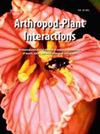Several studies on floral nectar demonstrated that the behaviour of visit performed by pollinators is influenced by nectar chemistry. Biogenic amines act as neurotransmitters in invertebrates and recently have been reported in the floral nectar of 15 plant species for the first time. However, both their occurrence in floral nectar and the effects of their nectar-like concentrations on bee behaviour remains largely unsubstantiated. To increase knowledge on the role of biogenic amines on plant–pollinator interactions, here we (i) investigated the biogenic amine composition of Echium vulgare nectar in relation to its floral sexual phases, and (ii) studied how an artificial solution enriched with nectar-like concentrations of tyramine affects the visit on flowers of bumblebees under semi-controlled conditions. The chemical analysis reported the presence of tyramine in E. vulgare nectar and no difference in concentration between the two sexual phases. To explore potential effects of tyramine on bee behaviour, we designed a new method consisting in zucchini flowers emptied of their natural nectar and refilled with artificial tyramine-enriched nectar, and we used bumblebee workers as pollinator model. We found that bees fed tyramine-enriched solution spent less time foraging on a single flower than those fed control solution, suggesting that their behaviour of visit was overall more dynamic. Our results highlight the importance of addressing further investigations on this emerging class of nectar compounds on insect cognition and behaviour, other than on its occurrence and distribution in nectar of other species.



